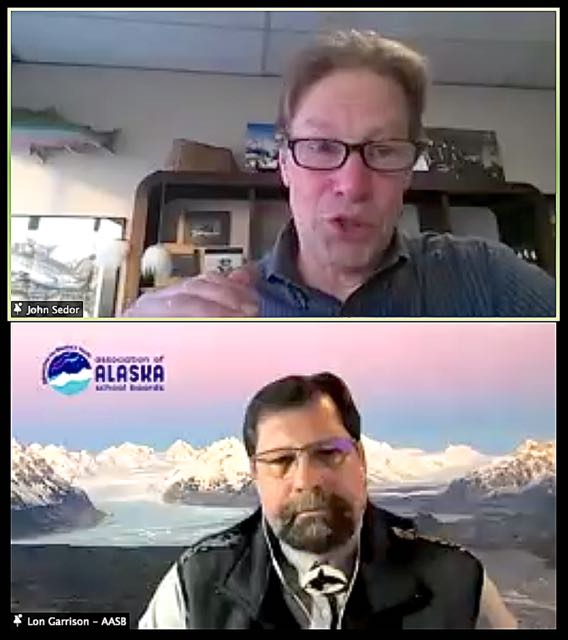Policies are Necessary, But Not Sufficient
Lon Garrison, AASB and John Sedor, Sedor Wendlandt Evans & Filippi

Lon Garrison urged board members to develop a clear understanding of school-based sexual boundary violations and implement policy to address it, to protect children and the district. AASB has worked on policy addressing Professional Boundaries of Staff with Students that is now available, and has already been adopted by some districts. However, the problem is large and is not going away.
It’s not as simple as the board adopting a policy and considering the work completed, he said. The paradigm also needs to change, which involves changing culture at the board and staff levels. AASB has put together a statewide working group to make sure training is available for boards, staff and communities.
“We have a vaccine for the pandemic of child abuse, and it’s identifying where boundary invasions occur and how they can be stopped,” Garrison said.
If your board has adopted these policies, it is important to stay informed on how the implementation process is going. Garrison suggested scheduling regular updates and building them into the board’s calendar.
He pointed out that school boards have a unique leadership role because, as elected officials, they have a direct connection with the community. Board members are entrusted to represent the community’s interests. If that trust is damaged because student safety is not protected, the board’s governance role can be jeopardized.
Setting expectations and guiding behaviors, while recognizing that strong relationships with students are also needed. Professional development for certified and uncertified staff will help to change behaviors that will change the culture. It’s the “doing” that makes the difference, he said.
The work of the Professional Boundaries Task force is ongoing, so be on the lookout for staff training thru APEI, and AASB training for boards. “I urge your board to adopt the AASB policies on this topic,” Garrison said. “We don’t want kids and districts to suffer.”
Attorney John Sedor said that adopting AASB policies is necessary, but that’s not all that needs to happen. Recurring training is also essential.
Board members are by definition a “lay board,” meaning they don’t have to be experts. However, just because you don’t have to know about something, doesn’t mean you shouldn’t know. The more you know, the better you will be able to ask the right questions.
Perpetrators are not easy to spot, Sedor said, and reporting them requires nuanced decision making.
“I can’t underscore enough that 99% of those who were abused wish they had not reported because of the negative social stigma they faced afterwards.” Sedor said. “What AASB is doing is critically important to change the expectations we have for school culture, but it won’t change without our involvement.”
It is important to know who is—and isn’t—a mandatory reporter. If you are not a mandatory reporter, you can still report in “good faith” and receive immunity. If you don’t want to report an incident yourself, tell an authority who is a mandatory reporter, such as the superintendent.
Board members are not mandatory reporters, but they can report. If someone tells a board members about suspected child abuse or neglect, what they can do is report it to OCS/law enforcement, or a mandatory reporter, which would be the superintendent, the board’s chief administrative officer and employee.
When reporting, be aware of lines of authority. For example, the school principal usually has a working relationship with the teacher in question, and sometimes they will divulge to the suspected perpetrator that there has been an allegation against them. The superintendent is the board’s employee, and a is mandatory reporter, so you will not be “bypassing” the principal by reporting an incident to the superintendent.
If you struggle with “What do I do?” the push is to report. With reporting you get immunity, without reporting you don’t. “Don’t let the information stop with you,” Sedor cautioned. “Further damage to the child can occur if a suspected incident is not reported.”
Besides the associated costs of not addressing child sexual abuse, unmeasured impacts on the school and district can include damage to student, parent, and community trust, which takes tremendous time and commitment to reestablish.
Abuse can occur in any size community, and yours is not immune. There is no prevalance of higher levels of child abuse occurring in larger or smaller communities. The difference is, in a smaller community more people may know the person being accused.
When it is the people around you being accused, it’s harder to accuse. Even people who are highly trained, and can see quirky behavior by someone they are acquainted with, may not be entirely convinced there is a problem.
Regarding grooming and boundary invasion, which way should you “lean” is almost always situational, and depends on the teacher and student involved. If you have reasonable cause to suspect that there is child abuse or neglect, you should report it. The goal is not to let the information stop with you.
DISCLAIMER
The information provided by presenters during the 2020 AASB Law & Policy Day, and included here, is for educational purposes only and does not constitute legal advice. If related legal advice is desired, please contact your attorney.
